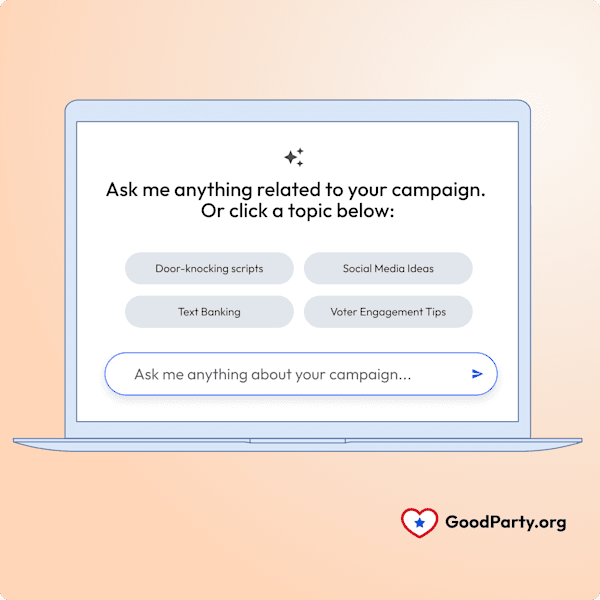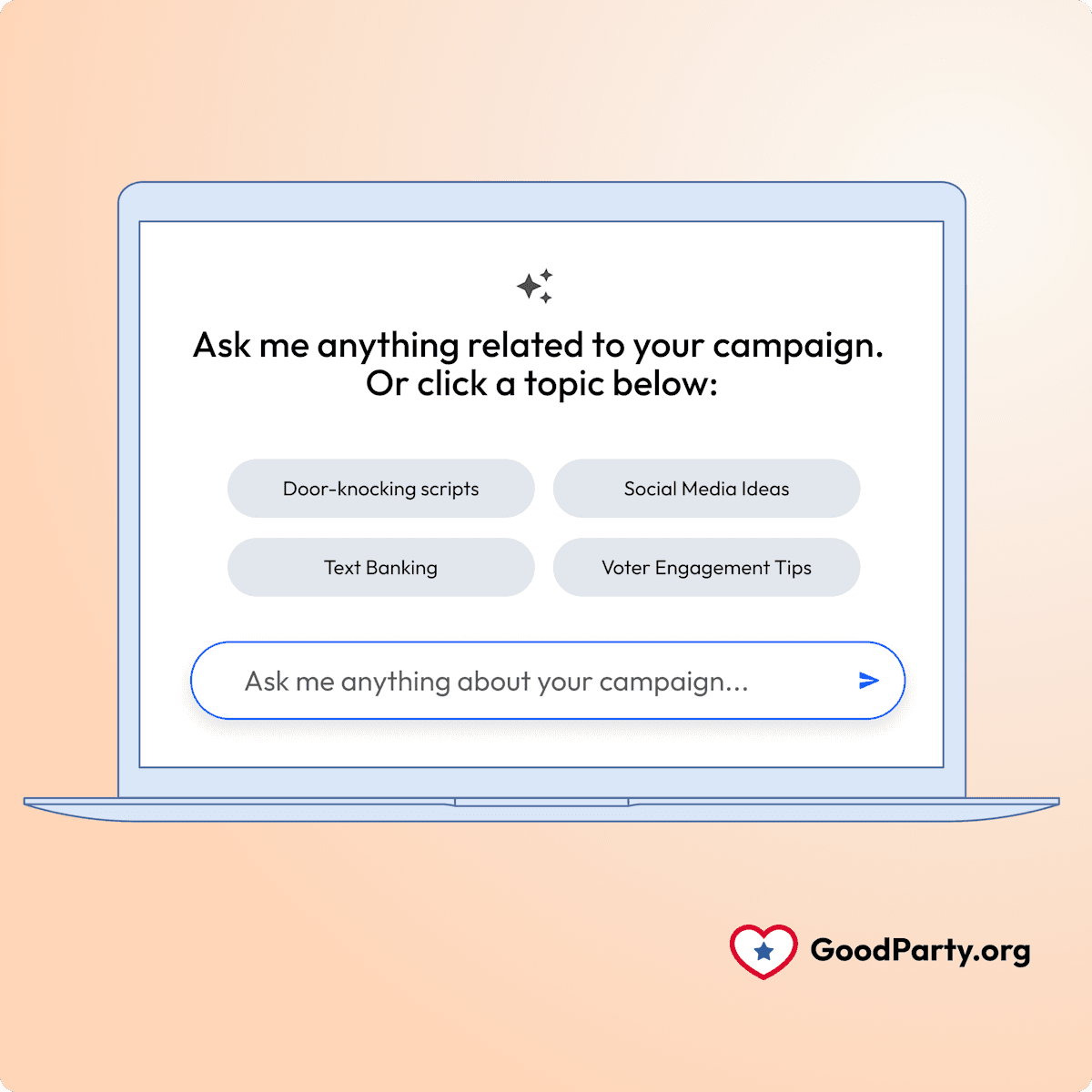
How to Write a Winning Canvassing Script for Your Campaign
When you're campaigning door-to-door, your canvassing script can make or break your voter conversations. For Independent and grassroots candidates, having a strong, customized script is one of the best ways to turn a knock on the door into a real connection and a vote.
Whether you're talking to neighbors yourself or training volunteers to do outreach, a good script helps you stay focused, confident, and consistent. With GoodParty.org, you don’t even have to start from scratch.
In this guide, we’ll walk you through how to create a custom canvassing script, what to say when campaigning door-to-door, and why it’s worth the time to get it right.
How to Create a Custom Canvassing Script
A canvassing script is a short, structured conversation guide designed to help you introduce yourself, deliver your message, and move the voter to action. The best political canvassing scripts feel natural, not robotic. They’re tailored to your campaign and your community, not pulled from a one-size-fits-all playbook.
Here’s how to build a script that works in the real world:
#1: Start With a Friendly Introduction
First impressions matter. Your script should open with a warm, simple greeting that includes:
Your name (or the volunteer’s name)
The campaign you’re with
The reason you’re stopping by
Here’s a quick example for volunteers and candidates:
Candidates can open with something like, "Hi, my name is Jamie Lee, and I'm running for city council here in Greenfield. I'm out talking to neighbors about the upcoming election."
Volunteers can introduce themselves by saying, “Hi, my name is Sarah, and I’m volunteering with Jamie Lee’s campaign for city council. We’re out today talking to neighbors about the upcoming election.”
#2: Ask an Engagement Question
A great script is just as much about listening as it is speaking. Adding an open-ended question can help you learn what matters most to voters and inform your campaign messaging moving forward.
Some open-ended questions you can ask include:
“What’s one thing you’d like to see change in our neighborhood?”
“What issues matter most to you this election season?”
“How do you feel your local government is doing right now?”
“Is there anything you wish more elected officials understood about our community?”
“What would make you more likely to vote in the upcoming election?”
“What’s been your biggest concern lately when it comes to [schools, public safety, housing, etc.]?”
“Do you feel like your voice is being heard in local decisions?”
These types of questions invite conversation, not confrontation. They also signal that your campaign is about listening, not lecturing.
LEARN MORE: Learn how to discuss current events with your voters and constituents.
#3: Share Your Campaign Message
Once you’ve introduced yourself and listened to the voter’s thoughts, it’s time to share what your campaign is all about. Instead of launching into a long speech, focus on a short, clear message that feels relevant to the person you're speaking with.
Think of this as your elevator pitch for the doorstep, one that speaks to local issues, communicates your values, and invites the voter to imagine a better future.
Here’s how to make it count:
Keep It Short and Clear: Aim for two to three sentences that explain what you’re running for and what you stand for.
Make It Local and Relatable: Your campaign message should reflect the realities of your community. Speak in everyday language about issues that impact people’s lives.
Speak from the Heart: People respond to authenticity. Share a bit about why you’re personally invested in this race, whether you’re a parent, teacher, renter, small business owner, or lifelong resident.
Tailor When You Can: If a voter just told you they’re worried about housing costs, safety, or schools, try to connect your message to their concern. Even a small adjustment shows that you’re really listening, not just reading a script.
As you canvass, you’ll get a feel for what resonates. Don’t be afraid to tweak your message as you go.
LEARN MORE: See how to craft a winning message for your campaign.
#4: Add a Clear Call to Action
A strong canvassing script should end with a direct and straightforward call to action (CTA) that tells the voter what you'd like them to do next.
The best CTAs are short, specific, and easy to follow. Think about what makes sense for the moment. Are you trying to earn their vote? Build your volunteer team? Collect contact info for follow-up?
Here are a few ways to craft your ask based on where the voter is in the process:
For voter identification or awareness, consider asking, “Can I leave this flyer with you so you can check us out online?” or “Would you like to stay in the loop with campaign updates?”
For contact collection and follow-up, ask, “Would you like a reminder when early voting starts?” or “Can I grab your phone number or email so we can follow up with voting info?”
For supporter conversion, ask something like, “Can we count on your vote?” or “Would you be willing to put up a yard sign or window flyer?”
For volunteer recruitment, you can say, “We’re looking for a few more volunteers to knock on doors. Would you be interested?” or “Even just sharing our campaign online helps a ton. Would you be open to doing that?”
Don’t forget to offer a low-lift option. Even if someone’s unsure, you can leave a flyer with your website and contact details, and let them know how to find more information.
The key to a call to action is to ask clearly and meet people where they are. Not every door ends in a yes, but every conversation is a step forward.
#5: Include a Quick Closing and Thank You
Wrap up your conversation with a polite, positive closing that leaves a good impression, even if the voter isn’t fully engaged or supportive yet.
A warm thank you shows respect for their time and reinforces your campaign’s values.
Some ways to wrap up your conversation are:
“Thanks so much for your time today. I really appreciate it.”
“It was great to meet you. Hope we can count on your support!”
“Thanks again. I’ll leave this flyer in case you want to learn more.”
If they’ve shared feedback or concerns, acknowledge that too. A thoughtful closing might not win a vote on its own, but it builds goodwill that can pay off later, especially when your campaign follows up.
#6: Leave Room for Notes
Remember to jot down feedback after your conversation before moving on to the next door. These notes help you follow up, spot trends, and improve future outreach.
LEARN MORE: Want help writing your own script? GoodParty.org’s campaign tools allow you to create canvassing scripts tailored to your community.
Why Custom Canvassing Scripts Matter
Every door you knock on is a chance to connect, but only if you’re prepared. Here’s why personalized canvassing scripts make such a big impact:
They build volunteer confidence. Custom scripts give your volunteers a clear path forward. New canvassers feel more prepared, and experienced ones stay on message.
They help you scale personalization. With GoodParty.org’s campaign tools, you can adapt your script to your voter lists and notes, reflecting past interactions, location, or top local issues.
They save you time and energy. Training new volunteers takes time. A great script shortens the learning curve and lets your team focus on meaningful dialogue instead of worrying about what to say.
At the end of the day, a good script helps your campaign stay focused, your volunteers feel confident, and your conversations move voters. It’s one of the simplest ways to improve your outreach and build real momentum, one door at a time.
How GoodParty.org Makes Canvassing Scripts Smarter
Running a campaign is hard work, especially when you're doing it outside the two-party system. That’s why GoodParty.org offers free and low-cost campaign tools designed specifically for Independent and non-partisan candidates.
Our campaign tools help you:
Create canvassing scripts tailored to your district, platform, and voter concerns
Adjust scripts in real time based on feedback and changing data
Align canvassing conversations with your voter file
Train your volunteers with clear, easy-to-use guides
Improve every interaction, from the first knock to the final GOTV push
Prefer a human touch over AI-powered tools? That’s totally okay. You can use our templates as a starting point and tweak them to reflect your voice. You can use our sample door-to-door script for early campaign canvassing, or check out our get-out-the-vote script for that final election day push.
Think of it as saving time, not replacing the personal touch.
LEARN MORE: See our picks for the best political campaign canvassing apps to make your outreach efforts as effective as possible.
Canvassing Scripts Are Just the Start
A canvassing script is one piece of a winning voter outreach strategy. To make your campaign truly people-powered, combine your script with:
A clear campaign field plan and walk lists
A team of trained, motivated volunteers
Consistent follow-up with supporters
Other outreach tactics like texting, phone calls, and community events
When done right, a custom canvassing script combined with a winning campaign plan can help you connect with voters, share your story, and move people to action.
With GoodParty.org, you don’t have to build your canvassing plan alone. From data-driven script builders to real-time tracking, we offer free and low-cost resources to help Independent and non-partisan candidates campaign smarter and win.
In a system stacked against everyday people, your conversations at the door matter more than ever.
Ready to level up your campaign? Book a free demo today to see how custom scripts can strengthen your ground game.
Frequently Asked Questions
- What is GoodParty.org?
- I’m curious about running for office. Where can I learn more?
- I’m not running for office, but I’d like to get involved. How can I support Independent candidates?

